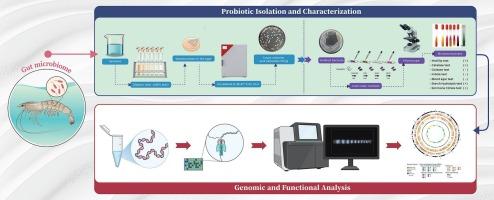Genomic insights into Bacillus sp. KNSH11 from Litopenaeus vannamei intestine: Probiotic potential, safety, and aquaculture applications
IF 2.2
2区 生物学
Q4 BIOCHEMISTRY & MOLECULAR BIOLOGY
Comparative Biochemistry and Physiology D-Genomics & Proteomics
Pub Date : 2025-09-11
DOI:10.1016/j.cbd.2025.101633
引用次数: 0
Abstract
In the context of sustainable aquaculture, probiotics represent a promising alternative to antibiotics for promoting shrimp health and disease resistance. In this study, Bacillus sp. KNSH11, a Gram-positive, rod-shaped bacterium isolated from the intestine of whiteleg shrimp (Litopenaeus vannamei), was characterized to assess its probiotic potential. The strain exhibited excellent sporulation efficiency (> 99 %), supporting its resilience under harsh environmental conditions. Functional assays demonstrated that KNSH11 retained high viability under various stressors, including acidic pH (2–4), bile salts, elevated temperatures (up to 95 °C), and lysozyme exposure, indicating robust tolerance to gastrointestinal and processing challenges. Metabolic profiling revealed substantial lactic acid production with minimal levels of acetate and propionate, distinguishing it from conventional lactic acid bacteria. The strain also exhibited strong antioxidant activity and moderate antibiofilm effects against pathogenic bacteria. Antibiotic susceptibility testing showed sensitivity to amoxicillin, chloramphenicol, kanamycin, and tetracycline (all at 30 μg/disc), while resistance was observed against ampicillin and penicillin (10 μg/disc each). Whole genome sequencing confirmed the absence of virulence genes and identified the presence of mobile genetic elements, a CRISPR/Cas system, and gene clusters potentially responsible for bacteriocin production. Collectively, these results indicate that Bacillus sp. KNSH11 exhibits key probiotic characteristics and genomic features consistent with a safe profile, supporting its potential application in sustainable shrimp aquaculture, pending further in vitro and in vivo validation.

凡纳滨对虾肠道KNSH11芽孢杆菌的基因组分析:益生菌潜力、安全性和水产养殖应用
在可持续水产养殖的背景下,益生菌是一种很有前途的抗生素替代品,可以促进对虾的健康和抗病性。本研究对从凡纳滨对虾(Litopenaeus vannamei)肠道分离的革兰氏阳性杆状芽孢杆菌(Bacillus sp. KNSH11)进行了鉴定,以评估其益生菌潜力。菌株表现出优异的产孢效率(bbb99 %),支持其在恶劣环境条件下的恢复能力。功能分析表明,KNSH11在各种应激条件下保持高活力,包括酸性pH值(2-4)、胆汁盐、高温(高达95°C)和溶菌酶暴露,表明对胃肠道和加工挑战具有强大的耐受性。代谢谱显示大量的乳酸生产与最低水平的醋酸和丙酸,区别于传统的乳酸菌。菌株对病原菌表现出较强的抗氧化活性和中等的抗生物膜作用。抗生素药敏试验对阿莫西林、氯霉素、卡那霉素和四环素敏感(均为30 μg/盘),对氨苄西林和青霉素均耐药(10 μg/盘)。全基因组测序证实了毒力基因的缺失,并鉴定了可能负责细菌素产生的移动遗传元件、CRISPR/Cas系统和基因簇的存在。总之,这些结果表明,芽孢杆菌sp. KNSH11具有关键的益生菌特征和基因组特征,符合安全的特征,支持其在可持续对虾养殖中的潜在应用,有待进一步的体外和体内验证。
本文章由计算机程序翻译,如有差异,请以英文原文为准。
求助全文
约1分钟内获得全文
求助全文
来源期刊
CiteScore
5.10
自引率
3.30%
发文量
69
审稿时长
33 days
期刊介绍:
Comparative Biochemistry & Physiology (CBP) publishes papers in comparative, environmental and evolutionary physiology.
Part D: Genomics and Proteomics (CBPD), focuses on “omics” approaches to physiology, including comparative and functional genomics, metagenomics, transcriptomics, proteomics, metabolomics, and lipidomics. Most studies employ “omics” and/or system biology to test specific hypotheses about molecular and biochemical mechanisms underlying physiological responses to the environment. We encourage papers that address fundamental questions in comparative physiology and biochemistry rather than studies with a focus that is purely technical, methodological or descriptive in nature.

 求助内容:
求助内容: 应助结果提醒方式:
应助结果提醒方式:


